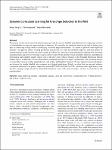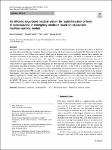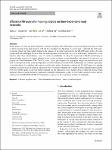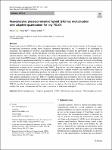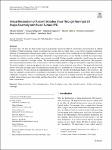Search
Author
- Osman, Ahmed I. (5)
- Daqing, Ma (3)
- Jorgensen, Ed (3)
- Li, Yan (3)
- next >
Subject
- kinh tế (26)
- Economics (12)
- programming (10)
- XRD (10)
- next >
Date issued
- 2020 - 2025 (2128)
- 2010 - 2019 (129)
- 2000 - 2009 (9)
- 1999 - 1999 (1)
Has File(s)
Search Results
In this work, we study resolvent splitting algorithms for solving composite monotone inclusion problems. The objective of these general problems is finding a zero in the sum of maximally monotone operators composed with linear operators. Our main contribution is establishing the first primal-dual splitting algorithm for composite monotone inclusions with minimal lifting. Specifically, the proposed scheme reduces the dimension of the product space where the underlying fixed point operator is defined, in comparison to other algorithms, without requiring additional evaluations of the resolvent operators. We prove the convergence of this new algorithm and analyze its performance in a problem arising in image deblurring and denoising. |
Incorporating machine learning into automatic performance analysis and tuning tools is a promising path to tackle the increasing heterogeneity of current HPC applications. However, this introduces the need for generating balanced datasets of parallel applications’ executions and for dealing with natural imbalances for optimizing performance parameters. This work proposes a holistic approach that integrates a methodology for building balanced datasets of OpenMP code-region patterns and a way to use such datasets for tuning performance parameters. The methodology uses hardware performance counters to characterize the execution of a given region and correlation analysis to determine whether it covers an unique part of the pattern input space. |
Bipartite secret sharing schemes realize access structures in which the participants are divided into two parts, and all the participants in the same part play an equivalent role. Such a bipartite structure can be described by the collection of its minimal points. The complexity of a scheme is the ratio between the maximum share size given to the participants and the secret size, and the Shannon complexity of a structure is the best lower bound provided by the entropy method. Within this work, we compute the Shannon complexity of regular bipartite structures and provide optimal constructions for some bipartite structures defined by 2 and 3 points. |
In this paper, techniques for dynamic load balancing of the cellular automata parallel execution are presented for the case of domain space partitioned along two dimensions. Starting from general closed-form expressions that allow to compute the optimal workload assignment in a dynamic fashion when partitioning takes place along only one dimension, we tailor the procedure to allow partitioning and balancing along both dimensions. Both qualitative and quantitative experiments are carried out that assess performance improvement in applying load balancing for the case of two-dimensional partitioned domain, especially when the load balancing takes place along both dimensions. |
In this paper, we construct multi-key homomorphic and fully homomorphic encryption (resp. MKHE and MKFHE) schemes with malicious circuit privacy. Our schemes are based on learning with errors (LWE) besides appropriate circular security assumptions. In contrast, the previous maliciously circuit-private MKFHE scheme by Chongchitmate and Ostrovsky (PKC, 2017) is based on the non-standard decisional small polynomial ratio (DSPR) assumption with a super-polynomial modulus, besides ring learning with errors and circular security assumptions. We note that it was shown by Albrecht et al. (CRYPTO, 2016) that there exists a sub-exponential time attack against this type of DSPR assumption. The main building block of our maliciously circuit-private MKFHE scheme is a (plain) MKFHE scheme by Brak... |
We propose a novel end-to-end curriculum learning approach for sparsely labelled animal datasets leveraging large volumes of unlabelled data to improve supervised species detectors. We exemplify the method in detail on the task of finding great apes in camera trap footage taken in challenging real-world jungle environments. In contrast to previous semi-supervised methods, our approach adjusts learning parameters dynamically over time and gradually improves detection quality by steering training towards virtuous self-reinforcement. To achieve this, we propose integrating pseudo-labelling with curriculum learning policies and show how learning collapse can be avoided. We discuss theoretical arguments, ablations, and significant performance improvements against various state-of-the-art... |
Emergency medicine (EM) is one of the attractive research fields in which researchers investigate their efforts to diagnose and treat unforeseen illnesses or injuries. There are many tests and observations are involved in EM. Detection of the level of consciousness is one of these observations, which can be detected using several methods. Among these methods, the automatic estimation of the Glasgow coma scale (GCS) is studied in this paper. The GCS is a medical score used to describe a patient’s level of consciousness. This type of scoring system requires medical examination that may not be available with the shortage of the medical expert. Therefore, the automatic medical calculation for a patient’s level of consciousness is highly needed. |
In this paper, we study the Time-Dependent k Nearest Neighbor (TD-kNN) query on moving objects that aims to return k objects arriving at the query location with the least traveling cost departing at a given time t. Although the kNN query on moving objects has been widely studied in the scenario of the static road network, the TD-kNN query tends to be more complicated and challenging because under the time-dependent road network, the cost of each edge is measured by a cost function rather than a fixed distance value. To tackle such difficulty, we adopt the framework of GLAD and develop an advanced index structure to support efficient fastest travel cost query on time-dependent road network. In particular, we propose the Time-Dependent H2H (TD-H2H) index, which pre-computes the aggreg... |
Deep neural networks (DNNs) have delivered unprecedented achievements in the modern Internet of Everything society, encompassing autonomous driving, expert diagnosis, unmanned supermarkets, etc. It continues to be challenging for researchers and engineers to develop a high-performance neuromorphic processor for deployment in edge devices or embedded hardware. DNNs’ superpower derives from their enormous and complex network architecture, which is computation-intensive, time-consuming, and energy-heavy. Due to the limited perceptual capacity of humans, accurate processing results from DNNs require a substantial amount of computing time, making them redundant in some applications. Utilizing adaptive quantization technology to compress the DNN model with sufficient accuracy is crucial f... |
In recent years, 3D data has been widely used in archaeology and in the field of conservation and restoration of cultural properties. Virtual restoration, which reconstructs the original state in virtual space, is one of the promising applications utilizing 3D scanning data. Though many studies of virtual restoration have been conducted, it is still challenging to restore the cultural properties that consist of multiple deformable components because it is not feasible to identify the original shape uniquely. As a solution to such a problem, we proposed a non-rigid 3D shape assembly method for virtually restoring wooden ships that are composed of multiple timbers. The deformed timber can be well represented by ruled surface. We proposed a free-form deformation method with a ruled sur... |






